Boyer George R. An Economic History of the English Poor Law, 1750-1850
Подождите немного. Документ загружается.

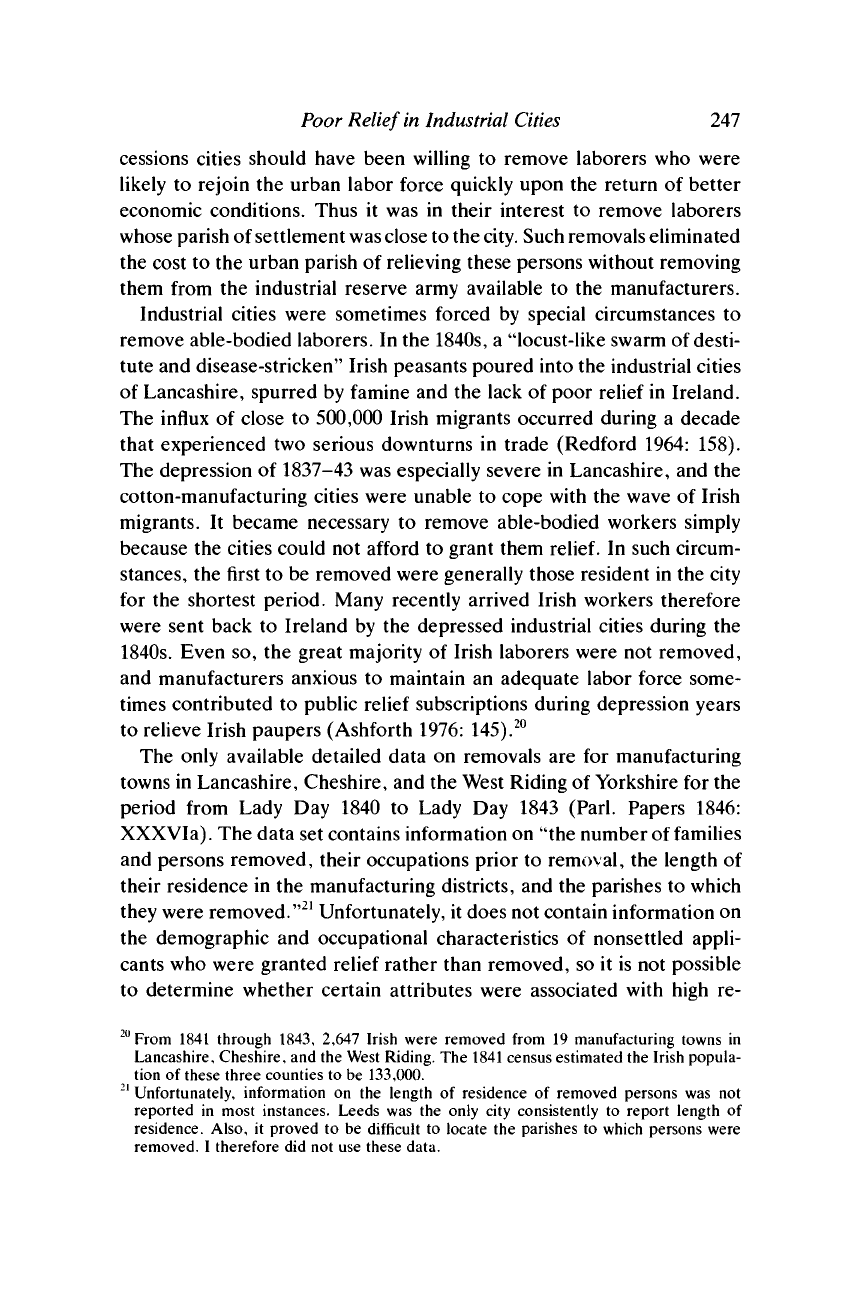
Poor
Relief
in
Industrial
Cities
247
cessions cities should have been willing
to
remove laborers
who
were
likely
to
rejoin
the
urban labor force quickly upon
the
return
of
better
economic conditions. Thus
it was in
their interest
to
remove laborers
whose parish of settlement
was
close to the
city.
Such removals eliminated
the cost
to the
urban parish
of
relieving these persons without removing
them from
the
industrial reserve army available
to the
manufacturers.
Industrial cities were sometimes forced
by
special circumstances
to
remove able-bodied laborers.
In the
1840s,
a
"locust-like swarm
of
desti-
tute
and
disease-stricken" Irish peasants poured into
the
industrial cities
of Lancashire, spurred
by
famine
and the
lack
of
poor relief
in
Ireland.
The influx
of
close
to
500,000 Irish migrants occurred during
a
decade
that experienced
two
serious downturns
in
trade (Redford
1964: 158).
The depression
of
1837-43
was
especially severe
in
Lancashire,
and the
cotton-manufacturing cities were unable
to
cope with
the
wave
of
Irish
migrants.
It
became necessary
to
remove able-bodied workers simply
because
the
cities could
not
afford
to
grant them
relief. In
such circum-
stances,
the
first
to be
removed were generally those resident
in the
city
for
the
shortest period. Many recently arrived Irish workers therefore
were sent back
to
Ireland
by the
depressed industrial cities during
the
1840s. Even
so, the
great majority
of
Irish laborers were
not
removed,
and manufacturers anxious
to
maintain
an
adequate labor force some-
times contributed
to
public relief subscriptions during depression years
to relieve Irish paupers (Ashforth 1976: 145).
20
The only available detailed data
on
removals
are for
manufacturing
towns
in
Lancashire, Cheshire,
and the
West Riding
of
Yorkshire
for the
period from Lady
Day 1840 to
Lady
Day 1843
(Parl. Papers
1846:
XXXVIa).
The
data
set
contains information
on "the
number
of
families
and persons removed, their occupations prior
to
removal,
the
length
of
their residence
in the
manufacturing districts,
and the
parishes
to
which
they were removed."
21
Unfortunately,
it
does
not
contain information
on
the demographic
and
occupational characteristics
of
nonsettled appli-
cants
who
were granted relief rather than removed,
so it is not
possible
to determine whether certain attributes were associated with high
re-
20
From 1841 through 1843, 2,647 Irish were removed from 19 manufacturing towns in
Lancashire, Cheshire, and the West Riding. The 1841 census estimated the Irish popula-
tion of these three counties to be 133,000.
21
Unfortunately, information on the length of residence of removed persons was not
reported in most instances. Leeds was the only city consistently to report length of
residence. Also, it proved to be difficult to locate the parishes to which persons were
removed. I therefore did not use these data.

248
An
Economic History of the
English Poor
Law
moval rates. However,
an
analysis
of
the characteristics
of
those persons
removed does offer some insight into industrial areas' removal policies.
A tabulation
of the
occupations
of
persons removed from
six
north-
western cities during
the
period from Lady
Day
1840
to
Lady
Day 1843
is presented
in
Table
8.6. The
occupations have been classified into
seven groups: general unskilled laborers, skilled laborers
in
declining
industries, skilled laborers
in
nondeclining textile occupations, female-
headed households
and
orphans, workers
in
building trades, domestic
workers,
and all
other occupations.
A
listing
of the
occupations
con-
tained
in
each classification
is
given
in the
Appendix
to
this chapter.
Because
of
the length
and
depth
of
the 1837-43 depression,
and
because
of the large influx
of
Irish workers
at
this time,
the
results should repre-
sent
an
upper-bound estimate
of
the share
of
able-bodied factory work-
ers among
the
persons removed.
A simple measure
of the
percentage
of
persons removed from indus-
trial areas
who
could
be
considered
a
permanent burden
on the
relief
rolls
can be
obtained
by
looking
at the
number
of
persons removed who
were either female heads-of-household
or
employed
in
declining indus-
tries.
Combining
the
two classifications yields
a
lower-bound estimate of
the percentage
of
persons removed who
did not
detract from
the
urban
labor supply,
as
viewed
by an
industrial area's manufacturers.
The per-
centage
of
persons removed over
the
three-year period who were either
female heads-of-household
or
employed
in
declining industries
was
46.4%
in the
West Riding
and
31.8%
in
Lancashire-Cheshire.
22
It var-
ied from
28.4% for
non-Irish removals from Stockport
to 88.6% for
Bradford.
23
Moreover, most persons classified as domestic servants were
probably single women,
and
should therefore be classified with the other
female heads-of-household.
It
is
also
not
clear
how the
removal
of
laborers
in the
building trades
or
of
laborers classified under "other occupations" affected
the
labor
supply
in the
factories.
It
could
be
argued that these persons,
who in
22
There is no reason to assume that such persons were removed only during years of
depressed economic activity, since they were as likely to be a burden on the parish during
times of normal economic conditions as during recessions. Especially in the case of single
women with young children, parish officials were anxious to remove them as soon as
they applied for
relief.
This classification of persons therefore must have made up a
significantly larger share of the families removed during times other than the depression
^
years
1840-3.
23
Every Irish person removed from Stockport over the period was listed as a laborer. The
occupational distribution of the Irish in the nearby cities of Manchester and Salford
suggests that the Stockport returns are of questionable validity.
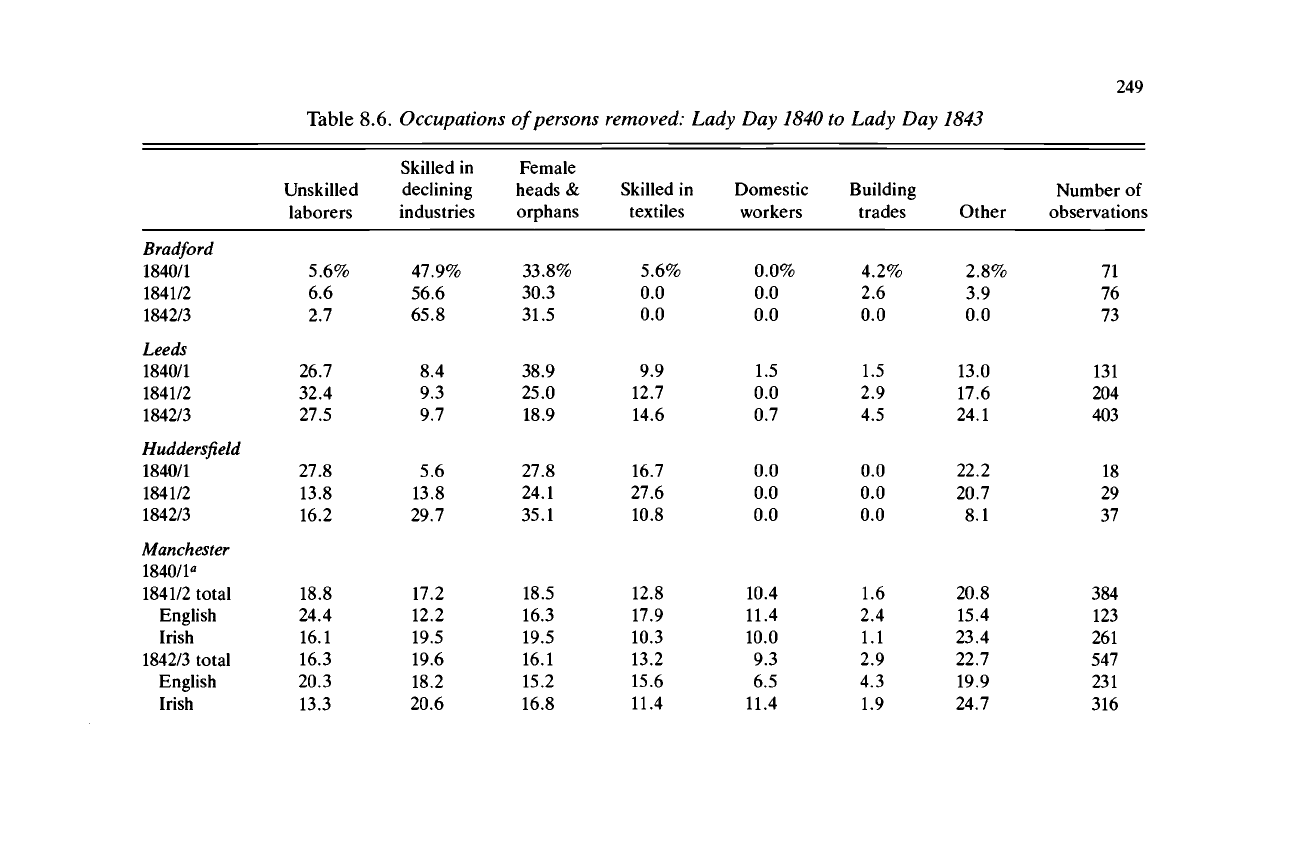
Table
8.6.
Occupations
of persons
removed:
Lady Day
1840
to Lady
Day
1843
Bradford
1840/1
1841/2
1842/3
Leeds
1840/1
1841/2
1842/3
Huddersfield
1840/1
1841/2
1842/3
Manchester
1840/1°
1841/2 total
English
Irish
1842/3 total
English
Irish
Unskilled
laborers
5.6%
6.6
2.7
26.7
32.4
27.5
27.8
13.8
16.2
18.8
24.4
16.1
16.3
20.3
13.3
Skilled
in
declining
industries
47.9%
56.6
65.8
8.4
9.3
9.7
5.6
13.8
29.7
17.2
12.2
19.5
19.6
18.2
20.6
Female
heads
&
orphans
33.8%
30.3
31.5
38.9
25.0
18.9
27.8
24.1
35.1
18.5
16.3
19.5
16.1
15.2
16.8
Skilled
in
textiles
5.6%
0.0
0.0
9.9
12.7
14.6
16.7
27.6
10.8
12.8
17.9
10.3
13.2
15.6
11.4
Domestic
workers
0.0%
0.0
0.0
1.5
0.0
0.7
0.0
0.0
0.0
10.4
11.4
10.0
9.3
6.5
11.4
Building
trades
4.2%
2.6
0.0
1.5
2.9
4.5
0.0
0.0
0.0
1.6
2.4
1.1
2.9
4.3
1.9
Other
2.8%
3.9
0.0
13.0
17.6
24.1
22.2
20.7
8.1
20.8
15.4
23.4
22.7
19.9
24.7
Number
of
observations
71
76
73
131
204
403
18
29
37
384
123
261
547
231
316
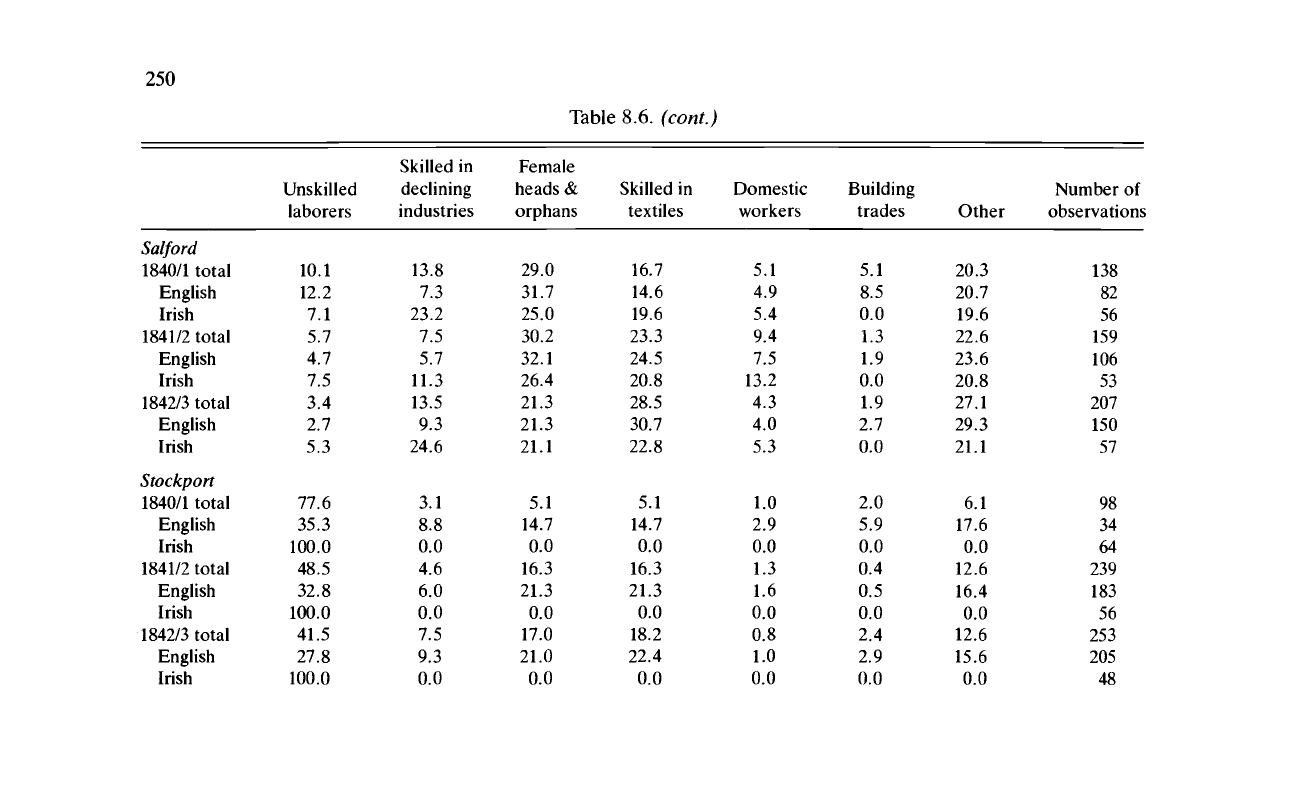
Table
8.6.
(cont.)
N
O
Salford
1840/1 total
English
Irish
1841/2 total
English
Irish
1842/3 total
English
Irish
Stockport
1840/1 total
English
Irish
1841/2 total
English
Irish
1842/3 total
English
Irish
Unskilled
laborers
10.1
12.2
7.1
5.7
4.7
7.5
3.4
2.7
5.3
77.6
35.3
100.0
48.5
32.8
100.0
41.5
27.8
100.0
Skilled
in
declining
industries
13.8
7.3
23.2
7.5
5.7
11.3
13.5
9.3
24.6
3.1
8.8
0.0
4.6
6.0
0.0
7.5
9.3
0.0
Female
heads
&
orphans
29.0
31.7
25.0
30.2
32.1
26.4
21.3
21.3
21.1
5.1
14.7
0.0
16.3
21.3
0.0
17.0
21.0
0.0
Skilled
in
textiles
16.7
14.6
19.6
23.3
24.5
20.8
28.5
30.7
22.8
5.1
14.7
0.0
16.3
21.3
0.0
18.2
22.4
0.0
Domestic
workers
5.1
4.9
5.4
9.4
7.5
13.2
4.3
4.0
5.3
1.0
2.9
0.0
1.3
1.6
0.0
0.8
1.0
0.0
Building
trades
5.1
8.5
0.0
1.3
1.9
0.0
1.9
2.7
0.0
2.0
5.9
0.0
0.4
0.5
0.0
2.4
2.9
0.0
Other
20.3
20.7
19.6
22.6
23.6
20.8
27.1
29.3
21.1
6.1
17.6
0.0
12.6
16.4
0.0
12.6
15.6
0.0
Number
of
observations
138
82
56
159
106
53
207
150
57
98
34
64
239
183
56
253
205
48
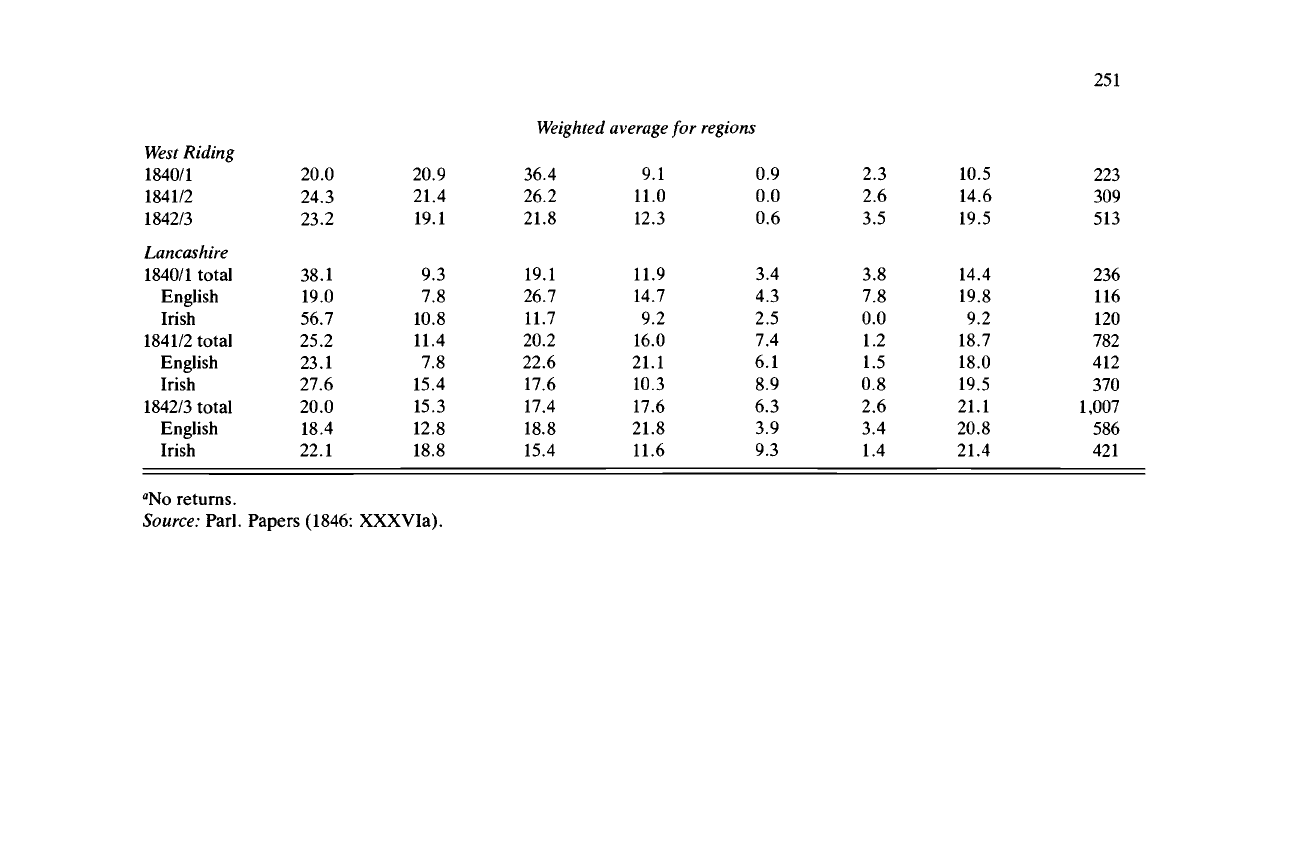
Weighted average
for
regions
West Riding
1840/1
1841/2
1842/3
Lancashire
1840/1 total
English
Irish
1841/2 total
English
Irish
1842/3 total
English
Irish
fl
No
returns.
Source:
Parl.
20.0
24.3
23.2
38.1
19.0
56.7
25.2
23.1
27.6
20.0
18.4
22.1
Papers
(1846:
20.9
21.4
19.1
9.3
7.8
10.8
11.4
7.8
15.4
15.3
12.8
18.8
XXX
Via).
36.4
26.2
21.8
19.1
26.7
11.7
20.2
22.6
17.6
17.4
18.8
15.4
9.1
11.0
12.3
11.9
14.7
9.2
16.0
21.1
10.3
17.6
21.8
11.6
0.9
0.0
0.6
3.4
4.3
2.5
7.4
6.1
8.9
6.3
3.9
9.3
2.3
2.6
3.5
3.8
7.8
0.0
1.2
1.5
0.8
2.6
3.4
1.4
10.5
14.6
19.5
14.4
19.8
9.2
18.7
18.0
19.5
21.1
20.8
21.4
223
309
513
236
116
120
782
412
370
1,007
586
421
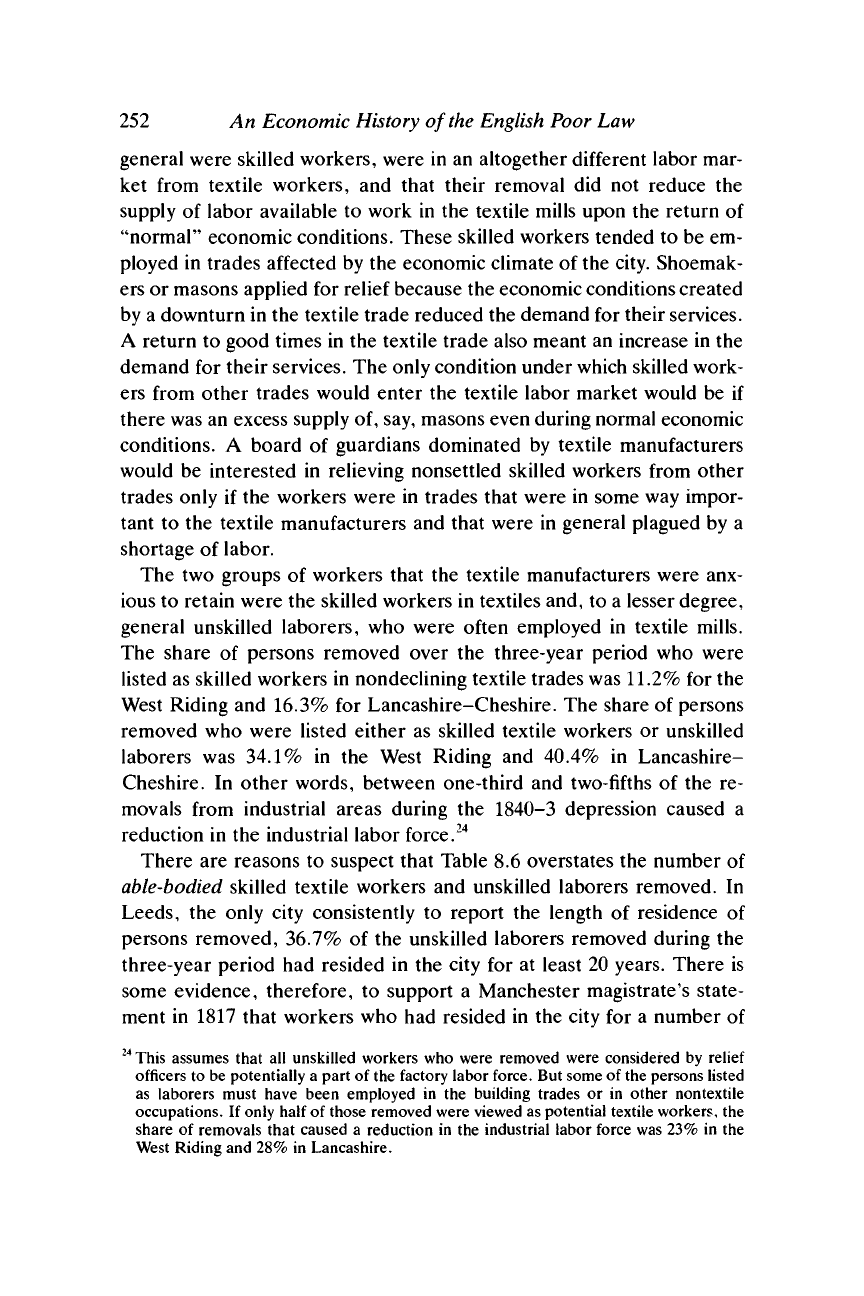
252 An Economic History of the
English
Poor Law
general were skilled workers, were in an altogether different labor mar-
ket from textile workers, and that their removal did not reduce the
supply of labor available to work in the textile mills upon the return of
"normal" economic conditions. These skilled workers tended to be em-
ployed in trades affected by the economic climate of the city. Shoemak-
ers or masons applied for relief because the economic conditions created
by a downturn in the textile trade reduced the demand for their services.
A return to good times in the textile trade also meant an increase in the
demand for their services. The only condition under which skilled work-
ers from other trades would enter the textile labor market would be if
there was an excess supply of, say, masons even during normal economic
conditions. A board of guardians dominated by textile manufacturers
would be interested in relieving nonsettled skilled workers from other
trades only if the workers were in trades that were in some way impor-
tant to the textile manufacturers and that were in general plagued by a
shortage of labor.
The two groups of workers that the textile manufacturers were anx-
ious to retain were the skilled workers in textiles and, to a lesser degree,
general unskilled laborers, who were often employed in textile mills.
The share of persons removed over the three-year period who were
listed as skilled workers in nondeclining textile trades was 11.2% for the
West Riding and 16.3% for Lancashire-Cheshire. The share of persons
removed who were listed either as skilled textile workers or unskilled
laborers was 34.1% in the West Riding and 40.4% in Lancashire-
Cheshire. In other words, between one-third and two-fifths of the re-
movals from industrial areas during the 1840-3 depression caused a
reduction in the industrial labor force.
24
There are reasons to suspect that Table 8.6 overstates the number of
able-bodied skilled textile workers and unskilled laborers removed. In
Leeds, the only city consistently to report the length of residence of
persons removed, 36.7% of the unskilled laborers removed during the
three-year period had resided in the city for at least 20 years. There is
some evidence, therefore, to support a Manchester magistrate's state-
ment in 1817 that workers who had resided in the city for a number of
24
This assumes that all unskilled workers who were removed were considered by relief
officers to be potentially a part of the factory labor force. But some of the persons listed
as laborers must have been employed in the building trades or in other nontextile
occupations. If only half of those removed were viewed as potential textile workers, the
share of removals that caused a reduction in the industrial labor force was 23% in the
West Riding and 28% in Lancashire.
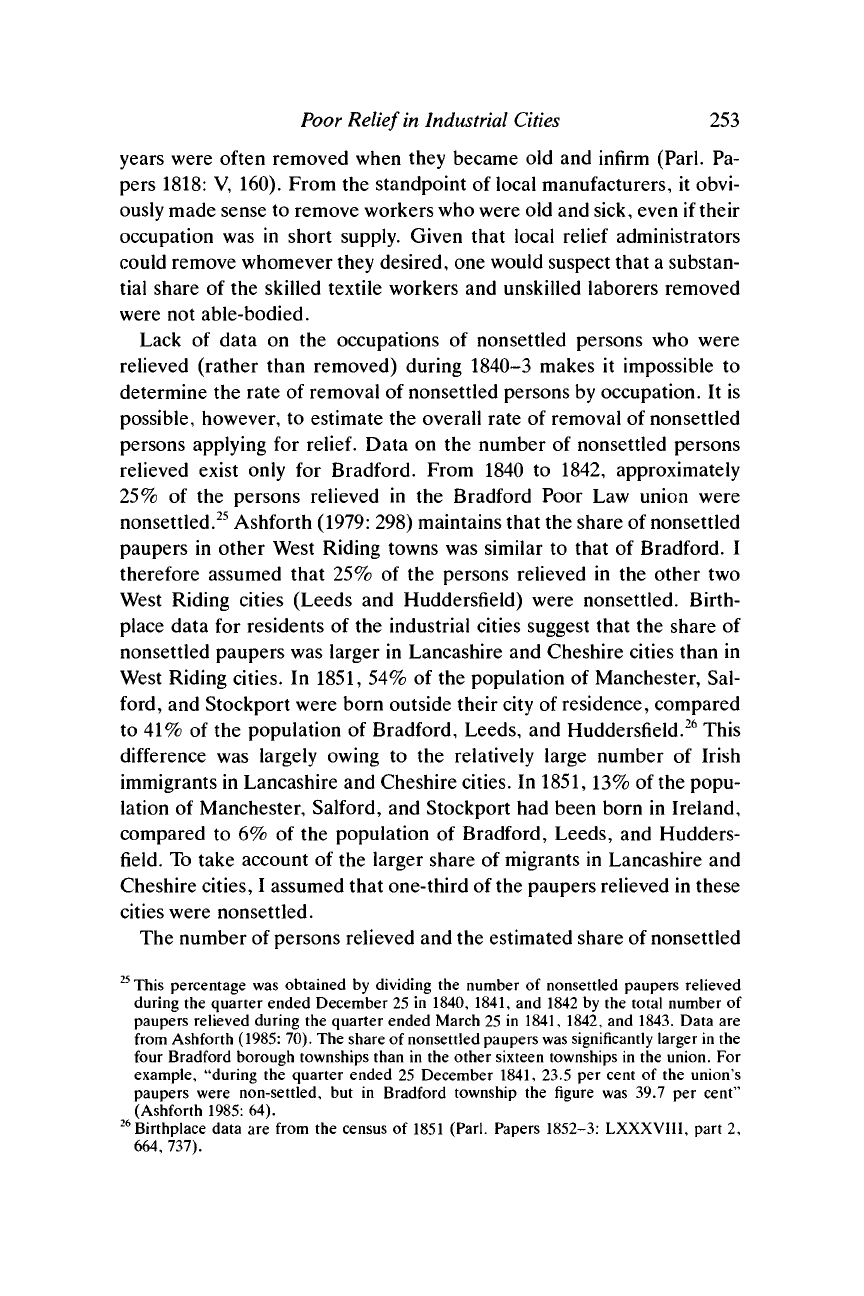
Poor
Relief
in
Industrial
Cities
253
years were often removed when they became
old and
infirm (Parl.
Pa-
pers 1818:
V,
160). From
the
standpoint
of
local manufacturers,
it
obvi-
ously made sense
to
remove workers who were
old and
sick, even
if
their
occupation
was in
short supply. Given that local relief administrators
could remove whomever they desired, one would suspect that
a
substan-
tial share
of the
skilled textile workers
and
unskilled laborers removed
were
not
able-bodied.
Lack
of
data
on the
occupations
of
nonsettled persons
who
were
relieved (rather than removed) during 1840-3 makes
it
impossible
to
determine
the
rate
of
removal
of
nonsettled persons
by
occupation.
It is
possible, however,
to
estimate
the
overall rate
of
removal
of
nonsettled
persons applying
for relief.
Data
on the
number
of
nonsettled persons
relieved exist only
for
Bradford. From
1840 to 1842,
approximately
25%
of the
persons relieved
in the
Bradford Poor
Law
union were
nonsettled.
25
Ashforth (1979: 298) maintains that
the
share
of
nonsettled
paupers
in
other West Riding towns
was
similar
to
that
of
Bradford.
I
therefore assumed that
25% of the
persons relieved
in the
other
two
West Riding cities (Leeds
and
Huddersfield) were nonsettled. Birth-
place data
for
residents
of the
industrial cities suggest that
the
share
of
nonsettled paupers
was
larger
in
Lancashire
and
Cheshire cities than
in
West Riding cities.
In
1851, 54%
of the
population
of
Manchester,
Sal-
ford,
and
Stockport were born outside their city
of
residence, compared
to
41%
of the
population
of
Bradford, Leeds,
and
Huddersfield.
26
This
difference
was
largely owing
to the
relatively large number
of
Irish
immigrants
in
Lancashire
and
Cheshire cities.
In
1851,13%
of
the popu-
lation
of
Manchester, Salford,
and
Stockport
had
been born
in
Ireland,
compared
to 6% of the
population
of
Bradford, Leeds,
and
Hudders-
field. To take account
of the
larger share
of
migrants
in
Lancashire
and
Cheshire cities,
I
assumed that one-third
of
the paupers relieved
in
these
cities were nonsettled.
The number
of
persons relieved
and the
estimated share
of
nonsettled
25
This percentage was obtained by dividing the number of nonsettled paupers relieved
during the quarter ended December 25 in 1840, 1841, and 1842 by the total number of
paupers relieved during the quarter ended March 25 in 1841, 1842, and 1843. Data are
from Ashforth (1985: 70). The share of nonsettled paupers was significantly larger in the
four Bradford borough townships than in the other sixteen townships in the union. For
example, "during the quarter ended 25 December 1841, 23.5 per cent of the union's
paupers were non-settled, but in Bradford township the figure was 39.7 per cent"
(Ashforth 1985: 64).
26
Birthplace data are from the census of 1851 (Parl. Papers
1852-3:
LXXXVIII, part 2,
664,
737).

254
An
Economic History of the
English Poor
Law
Table
8.7.
Statistics
on
number of removals
Poor Law Union 1841 1842 1843 Average
Number of paupers relieved: quarter ended Lady Day
Bradford 7,340 9,514 9,572
Huddersfield 6,880 9,431 13,092
Manchester 12,978 15,994 20,449
Salford 2,388 3,463 4,291
Stockport 3,918 8,153 6,895
Estimated % of nonresident paupers removed: year ended Lady Day
Bradford 18.1 9.7 8.3 11.0
Huddersfield 1.6 2.1 1.8 1.8
Manchester No returns 8.0 10.2 9.3
Salford 19.1 15.8 16.2 16.9
Stockport 11.9 12.6 15.8 13.7
Sources: Data on number of paupers relieved were obtained from Pad. Papers
(1844:
XL, 5, 12, 25). Data on number of nonresident paupers removed were
obtained from Parl. Papers (1846: XXXVIa).
paupers who were removed from each industrial city over
the
three-year
period
is
given
in
Table
8.7. The
removal rate was estimated
by
dividing
the number
of
persons removed during
any one
year
by the
estimated
number
of
nonsettled persons applying
for
poor
relief.
Data
on the
number
of
persons relieved
are
available only
for the
first quarter
of the
year, while
the
data
on
removals
are for the
entire year.
I
assumed that
the annual number
of
persons relieved
was
twice that
of the
number
of
persons relieved during
the
first quarter.
27
The
estimates
in
Table
8.7
show that, over
the
three-year period, between
10% and 15% of the
nonsettled persons
who
applied
for
relief were removed
to
their parish
of settlement.
28
A nonsettled person applying
for
relief faced
a
probability
of
removal
of 10-15%,
on
average. Assuming that
a
city's propensity
to
remove
persons who were expected
to be a
permanent charge
on the
relief rolls
was well above
15%,
the
probability
of
removal faced by
an
unemployed
27
My
assumption that
the
annual number
of
persons relieved
was
twice
the
number
re-
lieved
in the
first quarter
of the
year follows Ashforth (1985:
70).
This assumption
provides
a
lower-bound estimate
of the
number
of
persons relieved,
and
therefore
an
upper-bound estimate
of the
share
of
nonsettled relief applicants
who
were removed.
28
The probable explanation
for the low
removal rate from Huddersfield
is
that
it was
less
industrial than
the
other cities included
in
Table
8.7.
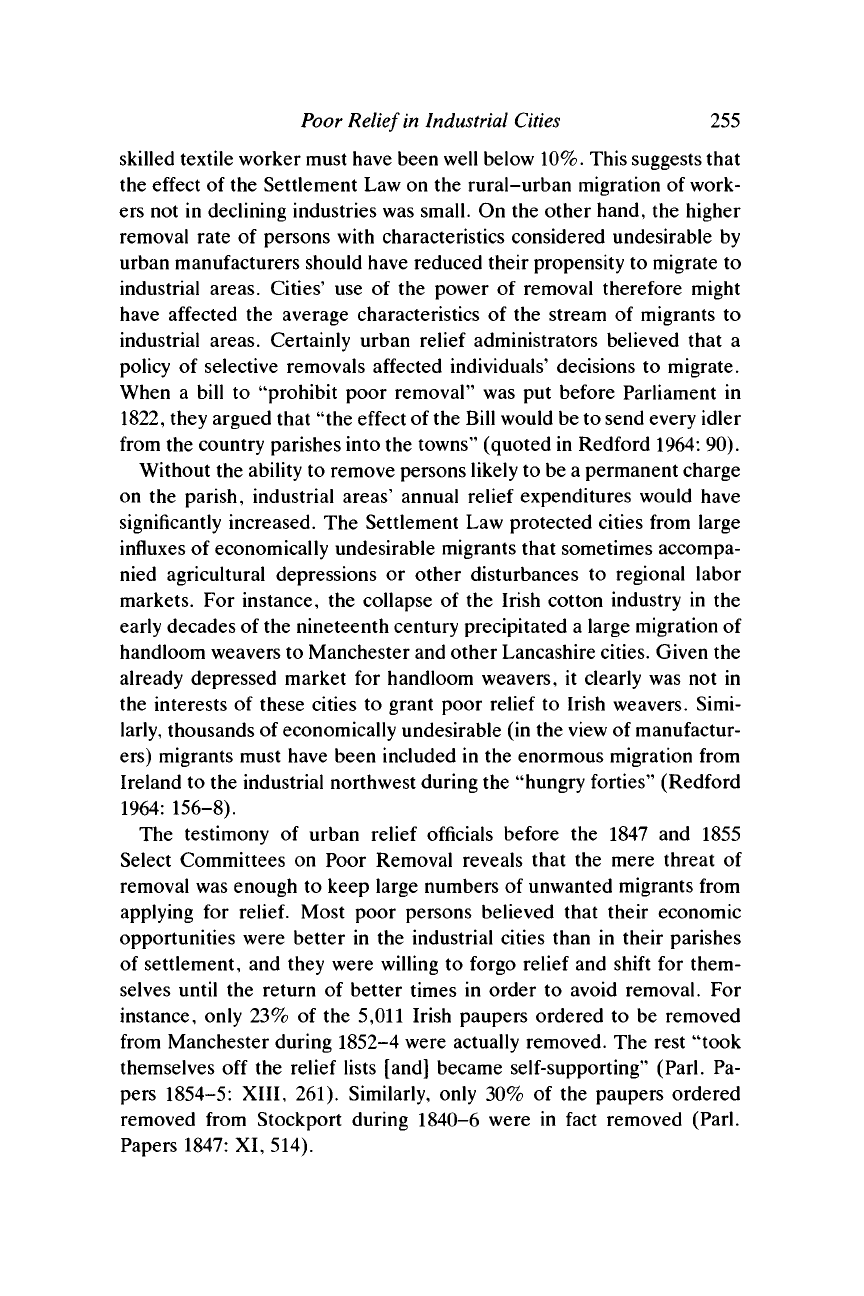
Poor
Relief
in Industrial Cities
255
skilled textile worker must have been well below 10%. This suggests that
the effect of the Settlement Law on the rural-urban migration of work-
ers not in declining industries was small. On the other hand, the higher
removal rate of persons with characteristics considered undesirable by
urban manufacturers should have reduced their propensity to migrate to
industrial areas. Cities' use of the power of removal therefore might
have affected the average characteristics of the stream of migrants to
industrial areas. Certainly urban relief administrators believed that a
policy of selective removals affected individuals' decisions to migrate.
When a bill to "prohibit poor removal" was put before Parliament in
1822,
they argued that "the effect of the Bill would be to send every idler
from the country parishes into the towns" (quoted in Redford 1964: 90).
Without the ability to remove persons likely to be a permanent charge
on the parish, industrial areas' annual relief expenditures would have
significantly increased. The Settlement Law protected cities from large
influxes of economically undesirable migrants that sometimes accompa-
nied agricultural depressions or other disturbances to regional labor
markets. For instance, the collapse of the Irish cotton industry in the
early decades of the nineteenth century precipitated a large migration of
handloom weavers to Manchester and other Lancashire cities. Given the
already depressed market for handloom weavers, it clearly was not in
the interests of these cities to grant poor relief to Irish weavers. Simi-
larly, thousands of economically undesirable (in the view of manufactur-
ers) migrants must have been included in the enormous migration from
Ireland to the industrial northwest during the "hungry forties" (Redford
1964:
156-8).
The testimony of urban relief officials before the 1847 and 1855
Select Committees on Poor Removal reveals that the mere threat of
removal was enough to keep large numbers of unwanted migrants from
applying for
relief.
Most poor persons believed that their economic
opportunities were better in the industrial cities than in their parishes
of settlement, and they were willing to forgo relief and shift for them-
selves until the return of better times in order to avoid removal. For
instance, only 23% of the 5,011 Irish paupers ordered to be removed
from Manchester during 1852-4 were actually removed. The rest "took
themselves off the relief lists [and] became self-supporting" (Parl. Pa-
pers 1854-5: XIII, 261). Similarly, only 30% of the paupers ordered
removed from Stockport during 1840-6 were in fact removed (Parl.
Papers 1847: XI, 514).
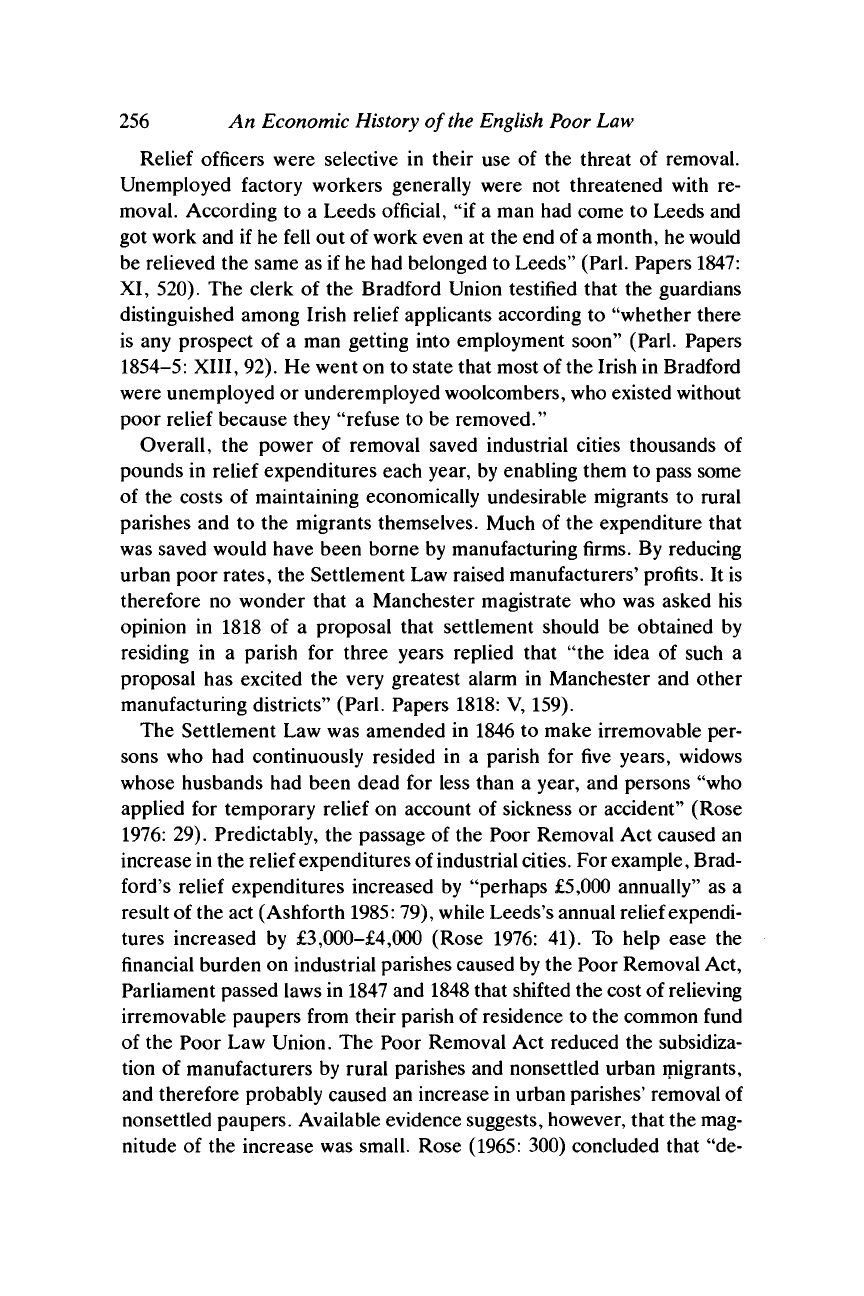
256 An Economic History of the
English Poor
Law
Relief officers were selective in their use of the threat of removal.
Unemployed factory workers generally were not threatened with re-
moval. According to a Leeds official, "if a man had come to Leeds and
got work and if he fell out of work even at the end of a month, he would
be relieved the same as if he had belonged to Leeds" (Parl. Papers 1847:
XI,
520). The clerk of the Bradford Union testified that the guardians
distinguished among Irish relief applicants according to "whether there
is any prospect of a man getting into employment soon" (Parl. Papers
1854-5:
XIII, 92). He went on to state that most of the Irish in Bradford
were unemployed or underemployed woolcombers, who existed without
poor relief because they "refuse to be removed."
Overall, the power of removal saved industrial cities thousands of
pounds in relief expenditures each year, by enabling them to pass some
of the costs of maintaining economically undesirable migrants to rural
parishes and to the migrants themselves. Much of the expenditure that
was saved would have been borne by manufacturing firms. By reducing
urban poor rates, the Settlement Law raised manufacturers' profits. It is
therefore no wonder that a Manchester magistrate who was asked his
opinion in 1818 of a proposal that settlement should be obtained by
residing in a parish for three years replied that "the idea of such a
proposal has excited the very greatest alarm in Manchester and other
manufacturing districts" (Parl. Papers 1818: V, 159).
The Settlement Law was amended in 1846 to make irremovable per-
sons who had continuously resided in a parish for five years, widows
whose husbands had been dead for less than a year, and persons "who
applied for temporary relief on account of sickness or accident" (Rose
1976:
29). Predictably, the passage of the Poor Removal Act caused an
increase in the relief expenditures of industrial
cities.
For example, Brad-
ford's relief expenditures increased by "perhaps £5,000 annually" as a
result of the act (Ashforth
1985:
79), while Leeds's annual relief expendi-
tures increased by £3,000-£4,000 (Rose 1976: 41). To help ease the
financial burden on industrial parishes caused by the Poor Removal Act,
Parliament passed laws in 1847 and 1848 that shifted the cost of relieving
irremovable paupers from their parish of residence to the common fund
of the Poor Law Union. The Poor Removal Act reduced the subsidiza-
tion of manufacturers by rural parishes and nonsettled urban migrants,
and therefore probably caused an increase in urban parishes' removal of
nonsettled paupers. Available evidence suggests, however, that the mag-
nitude of the increase was small. Rose (1965: 300) concluded that "de-
